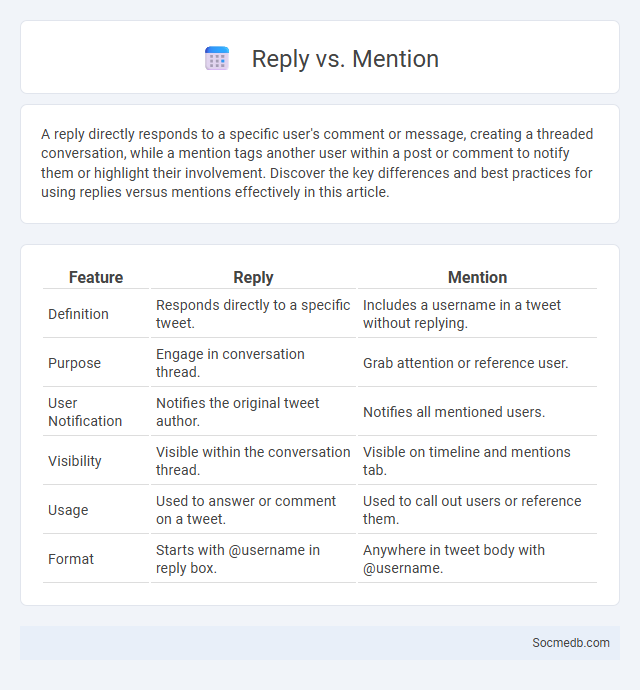
Photo illustration: Reply vs Mention
A reply directly responds to a specific user's comment or message, creating a threaded conversation, while a mention tags another user within a post or comment to notify them or highlight their involvement. Discover the key differences and best practices for using replies versus mentions effectively in this article.
Table of Comparison
| Feature | Reply | Mention |
|---|---|---|
| Definition | Responds directly to a specific tweet. | Includes a username in a tweet without replying. |
| Purpose | Engage in conversation thread. | Grab attention or reference user. |
| User Notification | Notifies the original tweet author. | Notifies all mentioned users. |
| Visibility | Visible within the conversation thread. | Visible on timeline and mentions tab. |
| Usage | Used to answer or comment on a tweet. | Used to call out users or reference them. |
| Format | Starts with @username in reply box. | Anywhere in tweet body with @username. |
Understanding "Reply" in Digital Communication
In digital communication, a "Reply" functions as a direct response to a specific message, facilitating interactive and threaded conversations on social media platforms like Twitter, Facebook, and Instagram. Replies help maintain context by linking back to the original content, allowing users to engage in focused discussions, clarify points, or provide feedback. Understanding the dynamics of replies enhances community engagement and supports clearer, more organized communication in online environments.
What Does "Mention" Mean Online?
A "mention" online refers to tagging or referencing a user, brand, or entity within social media posts, comments, or messages, often using the "@" symbol followed by the username. Mentions increase visibility and engagement by notifying the tagged party, fostering interaction and community building on platforms like Twitter, Instagram, and Facebook. Businesses and influencers leverage mentions to track brand sentiment, monitor audience response, and enhance digital marketing strategies.
The Core Differences Between Reply and Mention
Reply targets a specific user's comment directly, creating a threaded conversation that keeps your interaction visible within that dialogue, enhancing personal communication. Mention involves tagging a user by including their username in a post or comment, notifying them and bringing broader attention to your content across social media platforms. Understanding these distinctions empowers your engagement strategy for clearer, more effective online interactions.
How Replies Work on Social Media Platforms
Replies on social media platforms function as direct responses to specific posts or comments, fostering interactive conversations and enhancing user engagement. When you reply to a message, it notifies the original poster and often threads the conversation, making it easier to follow discussions. This mechanism helps organize dialogues and boosts visibility of related content within your social network.
Effective Use of Mentions in Conversations
Using mentions effectively in social media conversations boosts engagement by directly addressing specific users, ensuring your message reaches the intended audience. Strategic use of mentions increases visibility and can spark meaningful interactions, enhancing your online presence. To maximize the impact, tailor your mentions to relevant participants and encourage responses, making your social media dialogue more dynamic and personalized for your audience.
When to Choose Reply vs. Mention
Choose Reply on social media when directly addressing a specific comment within a thread to maintain conversation continuity and clarity. Use Mention to bring another user's attention to a new post or to include them in broader discussions without disrupting existing comment flows. Selecting the appropriate method enhances engagement accuracy and improves communication effectiveness across platforms like Twitter, Instagram, and LinkedIn.
Advantages of Using Replies
Using replies on social media enhances engagement by fostering direct communication and creating a sense of community around your content. Replies allow you to address questions or feedback promptly, improving customer satisfaction and building trust with your audience. Your active participation through replies boosts visibility and strengthens relationships, leading to increased brand loyalty and growth.
Benefits of Mentioning Others
Mentioning others on social media increases your post's visibility and encourages higher engagement by notifying those tagged, which can lead to shares and comments from their network. It fosters stronger connections and builds community by directly involving key individuals or brands in your content. This practice can also enhance your credibility and expand your reach by leveraging the influence of those you mention.
Common Mistakes: Mixing Up Reply and Mention
Mixing up reply and mention on social media often leads to miscommunication and reduced engagement, as replies are private conversations while mentions are public tags that notify users. You should use replies for direct interactions and mentions to include or alert someone in a broader conversation, ensuring clarity and proper notification. Confusing these functions can cause important messages to be overlooked or misunderstood by your audience.
Best Practices for Digital Engagement: Reply vs. Mention
Effective digital engagement on social media requires strategic use of replies and mentions to maximize reach and interaction. Replies foster direct conversations by targeting specific users in comment threads, enhancing relationship-building and personalized communication. Mentions increase visibility by tagging users in posts, expanding audience exposure and encouraging broader participation across platforms like Twitter, Instagram, and LinkedIn.
 socmedb.com
socmedb.com